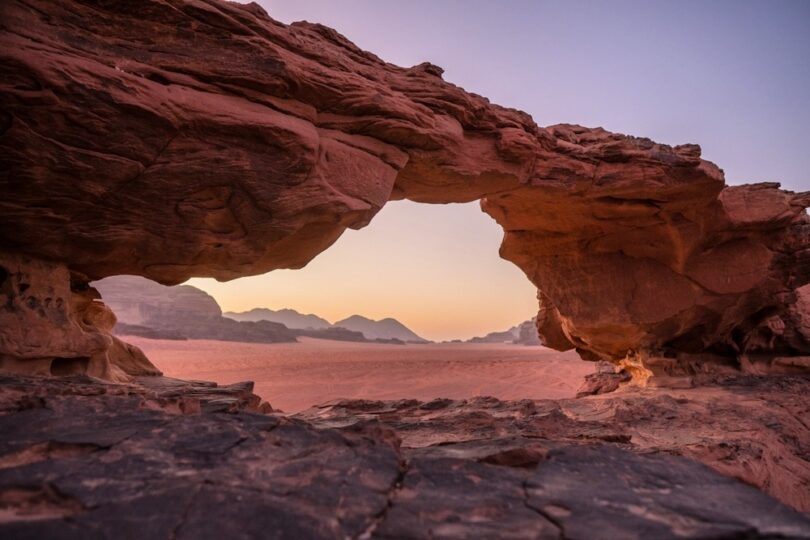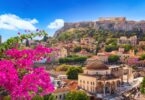Maybe in the course of your travels you’ve fantasized about visiting another world. The dream of whisking off to planets with fantastical landscapes and bizarre natural wonders unlike anything you can find on our very own terra firma is pretty appealing.
But as much as we’re rooting for private space companies, it doesn’t look like tourism to other planets is going to happen any time soon. That leaves us two options: taking in the breathtaking views of Mars from NASA rovers or trekking to some distinctive otherworldly destinations right here on our home planet.
So, here are a few “alien” landscapes you can visit.
Pamukkale — Turkey

Pamukkale, Turkey
Marvel at the stunning aqua blue water pools set within a towering white calcium fortress in Pamukkale, in western Turkey. These ethereal thermal pools are just an hour’s flight from Istanbul and have been attracting visitors for centuries, not to mention a great deal of attention on social media. Since the days of ancient Rome, people have sought the healing properties of these mineral-rich waters.
The name Pamukkale means “Cotton Castle” in Turkish, and as you explore this UNESCO World Heritage site you’ll understand why. The terraces, formed by the flowing thermal waters, create a breathtaking cascade of undeniable natural beauty. Don’t miss the nearby ancient city of Hierapolis, where you can wander through well-preserved ruins and envision life as it was thousands of years ago.
Lake Natron — Tanzania

Lake Natron, Tanzania
Visit the Arusha region in Tanzania to experience the ethereal beauty of Lake Natron, famous for its striking pink hues caused by the photosynthesizing pigment of cyanobacteria. This saline lake has fascinated scientists and travelers alike for centuries. Historically, Lake Natron has been a part of local Maasai culture, who have long known about its distinctive properties and the natural phenomenon it represents.
Be cautious, though — the water’s high pH can burn your skin, so it’s best to admire from a safe distance. As you explore, you’ll come across ghostly preserved animals that have died in the lake, their bodies calcified by the mineral-rich waters. This eerie sight adds to the feeling of being in an alien environment. Despite its harsh conditions, Lake Natron is a vital breeding ground for flamingos, who build their nests on the salty crust. During breeding season, the lake transforms into a bustling sanctuary, with thousands of flamingos adding to its surreal landscape.
Fingal’s Cave — Scotland

Fingal`s Cave, Scotland
Dare to venture close to the eerie Fingal’s Cave on the uninhabited Scottish island of Staffa, and you’ll be rewarded with the naturally-formed hexagonal basalt columns and the famous acoustics. Formed by volcanic activity over 50 million years ago, these amazing columns create a breathtaking sight. Its Gaelic name, An Uaimh Bhinn, means “the melodious cave,” and you’ll understand why as soon as you hear the waves echoing inside.
The cave has inspired many, including composer Felix Mendelssohn, who wrote his Hebrides Overture after visiting in 1829. Even famous writers like Jules Verne and poets like William Wordsworth have drawn inspiration from its stunning beauty. Fingal’s Cave is a true natural wonder, blending geological marvels with a rich cultural history that makes it a bizarre must-see destination.
Fly Geyser — Nevada

Fly Geyser, Nevada
Want to keep it local? Check out this man-made geothermal geyser, created accidentally by well drillers in the 1960s. Located on a private ranch in Washoe County, Nevada, it’s surrounded by a fence to keep visitors at a safe distance. But don’t worry, it’s big enough enough to admire from afar!
The Fly Geyser, as it’s called, is a striking sight with its vibrant, multi-colored terraces created by minerals and thermophilic algae. It continuously spews hot water, creating a surreal landscape that looks straight out of a science fiction movie. While you can’t get up close, the mesmerizing colors and formations make it an unforgettable view from a distance.
Zhangye Danxia — China

Zhangye Danxia National Geopark, China
Walking around Zhangye Danxia Geological Park in the Gansu province of China will make you feel like an astronaut exploring a distant planet. This incredible park is famous for its vibrant, rainbow-colored rock formations, which are the result of red sandstone and mineral deposits being pressed together over 24 million years. The striking colors and surreal landscapes are a photographer’s dream.
As you explore the park, you’ll find that each rock formation and cliff is distinctively patterned with various shades of red, yellow, green, and blue. The park was designated a UNESCO World Heritage site in 2010, recognizing its geological and aesthetic value. The well-maintained walkways and viewing platforms allow you to safely enjoy the stunning scenery from multiple angles.
Wadi Rum — Jordan

Wadi Rum, Jordan
Up for an unforgettable adventure? Then be ready to explore the Wadi Rum Protected Area in southern Jordan, a valley carved through granite and sandstone that’s nicknamed the Valley of the Moon. This stunning landscape has even doubled for Mars in the film “The Martian.” Here you can see ancient petroglyphs etched by the Nabataeans, who once traversed this land. The area is also famous for its towering rock formations, narrow gorges, and vast desert vistas.
Visitors can enjoy activities like camel rides, jeep tours, and even hot air ballooning for a bird’s-eye view of this breathtaking desert. Stay overnight in a Bedouin camp to experience traditional hospitality and gaze at the star-filled sky for an epic experience.
Svinafellsjokull Glacier — Iceland

Svínafellsjökull Glacier, Iceland
With its bleak and frozen landscape, Svinafellsjokull Glacier became a natural stand-in for the frozen planet in the 2014 movie “Interstellar.” The vast ice cap covers over 8% of Iceland. While the glacier’s intimidating, uninhabitable appearance might give you pause, the experience of visiting is truly amazing. You’ll find plenty of activities to enjoy, from ice climbing and glacier hiking to exploring ice caves that change shape and color with the seasons. Besides, the park itself is home to a rich and diverse wildlife and stunning scenery, including volcanoes, waterfalls, and geothermal areas.
Vaadhoo Island — Maldives

Maldives
When you visit Vaadhoo Island in the Maldives, you have the chance to experience its famous “sea of stars.” This spectacular phenomenon is created by bioluminescent phytoplankton that wash onto the shore at night, illuminating the beach with an ethereal blue glow. The tiny organisms emit light when disturbed, making the waves sparkle like stars.
Paddle around amidst these glowing lights and gaze up at the clear night sky filled with countless stars. Vaadhoo Island offers more than just its luminous beaches; it also provides opportunities for snorkeling, diving, and exploring the rich marine life of the Maldives.
Mount Roraima — Venezuela

Mount Roraima, Venezuela
One look at Mount Roraima in Canaima National Park, Venezuela, with its sheer cliff sides and flat rock top jutting out above the clouds, and you’ll think it was created by aliens. But this tepui — “or table-top mountain” — is actually a naturally forming wonder. Standing at 2,810 meters (9,219 feet), Mount Roraima is one of the oldest geological formations on Earth, dating back around two billion years to the Precambrian era. The shape of Mount Roraima has inspired many legends and stories among the local indigenous Pemon and Kapon tribes, who consider it a sacred site.
The hike to the summit is challenging but incredibly rewarding, taking you through diverse landscapes, from dense rainforest to rugged cliffs. Once at the top, you’ll be greeted with stunning views, strange rock formations, and diverse flora and fauna found nowhere else on Earth.
You Might Also Enjoy: Fancy a Trip to Arrakis? Explore These Real-Life Dune Movie Locations
Salar De Uyuni — Bolivia

Salar de Uyuni, Bolivia
No matter how you look at the world’s largest salt flat, located in Bolivia, you’ll probably do a double-take at its unearthly vista. Salar de Uyuni spans over 10,000 square kilometers — that is, 3,900 square miles — and offers an otherworldly experience with its vast, flat expanse stretching out into an unending horizon.
During the rainy season, a thin layer of standing water transforms the salt flat into a giant mirror, perfectly reflecting the sky and creating an illusion of walking on air. This landscape was formed from the prehistoric Lago Minchin, which evaporated over thousands of years, leaving behind a thick crust of salt and minerals. Besides its stunning views, the salt flat is also home to Isla Incahuasi, a rocky outcrop covered in giant cacti, and serves as a vital resource for lithium extraction.
FAQs:
Q: Can I visit these destinations year-round, or are there specific seasons that are better?
A: Each destination has optimal times to visit. For example, Salar de Uyuni is best visited during the dry season (May to October) due to its mirror effect. Lake Natron is pleasant from June to October, when temperatures are cooler. Research the best time based on your preferred activities and climate preferences.
Q: Are these destinations safe for solo travelers, or should I go with a guided tour?
A: Safety can vary by location. Some places, like Wadi Rum and Pamukkale, are popular and well-regulated for tourists. Others, like Mount Roraima, may require guides due to challenging terrain. Check local advisories, travel forums, and consider guided tours for unfamiliar areas.
Q: What are the accommodations like at these remote destinations?
A: Accommodations range from basic lodges to luxury resorts depending on the destination. Pamukkale offers hotels and thermal spa resorts. In contrast, Mount Roraima may only have camping options. Book accommodations in advance, especially during peak seasons.
Q: How can I prepare for the high altitudes or extreme climates in some of these places?
A: Altitude sickness and extreme temperatures can affect certain destinations like Salar de Uyuni or Svinafellsjokull Glacier. Stay hydrated, acclimatize slowly, and pack suitable clothing layers. Consult your doctor before travel, especially if you have health concerns.
Q: What activities can I expect at these destinations beyond sightseeing?
A: Activities vary widely. At Zhangye Danxia, enjoy hiking and photography. Lake Natron offers birdwatching and flamingo spotting. Salar de Uyuni allows for stargazing and exploring cactus-covered islands. Research activities beforehand and book tours for specialized experiences.
Q: Are there any cultural considerations or etiquette I should be aware of?
A: Respect local customs and wildlife conservation efforts. In Wadi Rum, dress modestly out of respect for the Bedouin culture. Follow Leave No Trace principles and avoid disturbing wildlife, especially at sensitive sites like Vaadhoo Island’s bioluminescent beach.
Q: How do I handle photography and drone use at these locations?
A: Check local regulations before using drones or cameras. Some areas, like Pamukkale or Fingal’s Cave, may have restrictions to protect fragile environments or cultural sites. Respect the proper guidelines to preserve these natural wonders for future generations.
Did we miss any other alien-looking landscapes to visit on Earth? Let us know in our comments section below!









The one in Turkey looks so amazing, also thi is very geat list. hope I can visit to one of these place someday.
This place looks so unreal. hope I can visit someday!